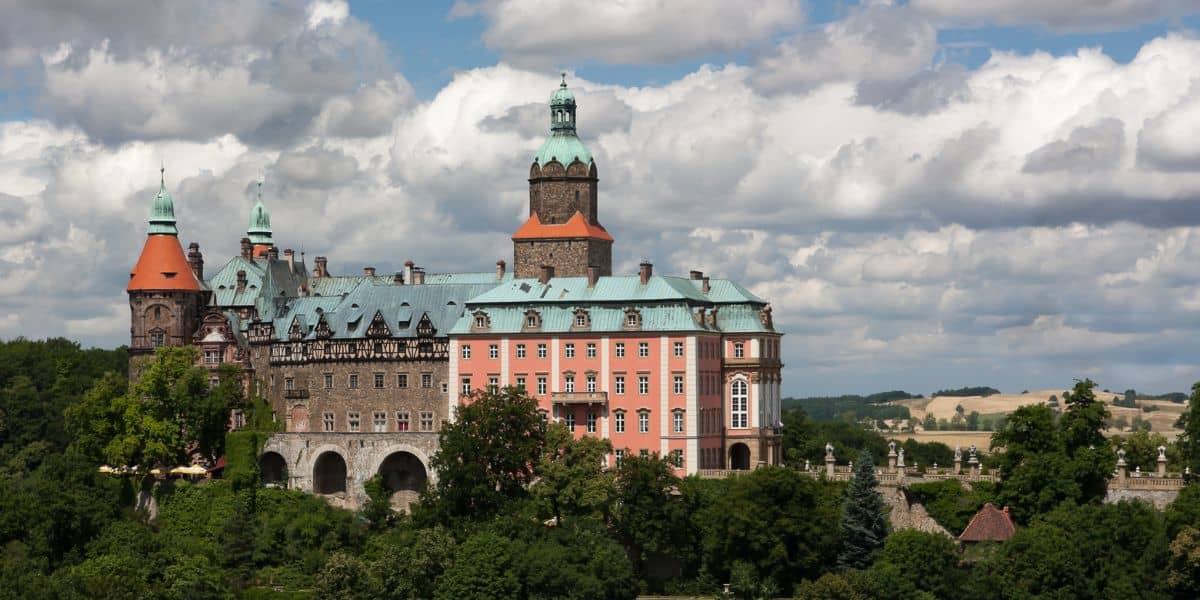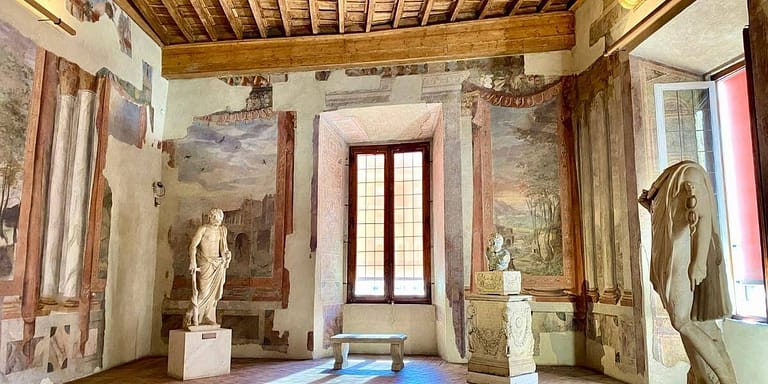15 Stunning castles in Poland you should visit
If you love castles (let’s be honest, who doesn’t?), you’ll love visiting the castles in Poland. With over 500 castles, 2,500 palaces and manor homes, there is something for everyone to enjoy. Whether you like your castles as ruins, with ghosts and legends, or meticulously restored, you’ll find them here.
Poland’s impressive castles tell tales of sieges, hidden treasures, and fortunes, both won and lost. They stand as a testament to war, determination and power. Some were built as fortifications, while others were family homes of the nobility. They are parts of Polish history, from the defensive fortress built by the Teutonic Knights to the Renaissance royal homes of the Polish kings and everything in between.
Affiliate Disclosure – This post contains affiliate links. If you make a purchase through these links, I may earn a commission. This doesn’t affect your purchases or any fees you may pay for the product or service. Read more in my DISCLAIMER.
While many have become museums and educational centres showcasing Poland’s rich history, others function as luxury hotels, event venues and movie sets. There are so many options for experiencing the best castles in Poland. As I can’t cover all of them in one post, here is a bit of a taste for your castle bucket list.

15 Castles in Poland for your bucket list
It’s not a secret that I am fond of castles, palaces, manor homes and villas. I love visiting medieval fortresses, Baroque places and former homes of the nobility. From the meticulously renovated to those in ruins that speak of former glory, I love them all. If you’re reading this, I assume you love them too.
Baranów Sandomierski Castle
The pretty Baranów Sandomierski Castle in southern Poland has been devastated by numerous fires since it was built between 1591 and 1603 for the Leszczynski family. Fashioned in the Renaissance style, it’s one of Poland’s best examples of this architectural style. It is believed that the Italian architect Santi Gucci designed the original Baranów Sandomierski Castle.

The castle changed hands between various noble families that employed the finest architects to reconstruct, expand and modernize the castle. A fire in 1849 destroyed the extensive art collections, valuable paintings, rare furniture and large parts of the structure. Another fire broke out in 1898, devastating the restored building and destroying the historic interior. The war wasn’t kind to the castle, and much of it was destroyed and plundered by the Germans and the Soviets.
Like many other Polish castles, this one was rebuilt after the war. Today it attracts tourists and architecture lovers. Visitors can tour the Baranó Sandomierski Castle, the courtyard, armoury, chapel and the surrounding park.
Czocha Castle
The Czocha Castle was originally a fortress with defensive walls built into a rock in the Middle Ages. With a colonnade bridge over a moat, a circular tower and Gothic rooftops, the castle is something straight out of a fairy tale. Due to the castle’s strategic position, it functioned as a defensive structure meant to withhold sieges. Like many other castles, it changed hands numerous times.

In 1909, Ernst Gütschow, a cigar manufacturer from Dresden, purchased the Czocha Castle and converted it into a luxury estate. He restored parts of the castle, added new elements, and filled it with priceless art and valuable objects. It’s not entirely known what renovations took place as there is no paper trail. However, numerous underground spaces, mysterious chambers and rooms throughout the castle add to the mystery of Czocha.
Today, Czocha Castle is a historical museum, spa, hotel and event centre. The castle is also a popular setting for movies and documentaries. There is also a restaurant and a wine cellar specializing in Polish cuisine.
Gniew Castle
Gniew Castle is another former Teutonic Order stronghold thought to have been first constructed in the 13th century. In 1466, Gniew fell under Polish ownership and underwent necessary repairs. It was later destroyed by the Swedes during the 17th century.

After Poland’s partition, the Prussians took over the castle, using it as a grain warehouse and later as a prison. They demolished several original features, including the main tower. The castle burned down again in 1921, and the restoration finally started in 1969. Today, it’s a popular tourist attraction and a hotel.
Goluchów Castle
Reminiscent of the castles in the Loire Valley, Goluchów Castle is a fine example of the French Renaissance style of the 19th century. With an extensive library and museum collections, it remains one of the most impressive aristocratic manors in the country and plays a significant role in Polish cultural heritage.

The construction of the castle was done by the Leszczynski family during the 16th century on the remnants of a previous fortification. Renovations, improvements and expansions continued with subsequent owners. During the 19th century, Goluchów was remodelled in the French style we see today.
The castle held an extensive collection of art, vases, furniture and other valuable objects collected by the owners. Many of the items were stored during the war, while many others were stolen and returned to Poland after the war.
Kórnik Castle
Resembling the Renaissance palaces of Italy, Kórnik Castle is a stunner that will appeal to all castle enthusiasts. Surrounded by a water moat and accessed through a bridge, the castle rises out of the water like something out of a fairy tale. It also comes with the ghost of a woman, known as the White Lady, searching for her beloved.
The Kónik Castle, originally built by the Górka family in the 14th century, was remodelled extensively by subsequent owners. The castle got a Renaissance makeover during the 16th century. Then a French-inspired facelift during the 18th century. Additional English neo-Gothic touches were added during the 19th century.

Unlike many other Polish castles, Kórnik avoided destruction during the war. The castle’s last owner donated Kórnik Castle to the state in 1924. During its lifetime, its owners entertained King Henry III of France in 1574 and King Zygmunt III (Sigismund III Vasa) in 1623.
Today, Kórnik Castle houses one of Poland’s largest libraries with an extensive collection of over 400,000 toms, including approximately 30,000 books over 150 years old. There are also many manuscripts, documents and old prints. You can admire the extensive assortment of furniture, paintings, sculptures, and other valuable objects owned by the families that lived here. In addition to personal belongings, there is also an extensive collection of military weaponry.
Krzyztopór Castle
The Krzyztopór Castle is an example of what having deep pockets, wild imagination and bad luck look like. The castle was built by Krzysztof Ossolinski, a Polish nobleman who wanted to impress his contemporaries. The construction was done in three phases, between 1619 and 1644, costing 3 million PLZ.
The castle combines the function of a fortress with that of a presidential palace. It is designed based on a pentagon-style base modelled on a calendar. There were as many windows as days in a year, and the chambers matched the number of weeks with rooms for each month and four towers that reflected the seasons. Inspired by the Italian palaces, it was as opulent as it was grand.

Ossolinski was well-versed in many subjects, including architecture, literature and politics. He loved symmetry, symbolism and design. Unfortunately, he died a year after the completion of Krzyztopór Castle. A few years later, his only son died in a battle, leaving the castle to pass to various family members.
The castle was pillaged and damaged during the Swedish invasion in 1655. The family remained in one of the wings as reconstruction was too costly. It was further damaged in 1770 after the Russian invasion and eventually deserted in 1787. Today, the castle ruins host tournaments and knight battles.
Ksiaz Castle
Ksiaz Castle sits on a wooded clifftop, surrounded by a forest and overlooking a pretty river. It is the third-largest castle in Poland and the largest in the Silesia region. If you like fairy tale castles in picturesque settings that come with Nazi mysteries, ghosts and missing gold, Ksiaz Castle is for you.
The castle’s origins are unclear. The first written mentions can be traced to the late 13th century when the Silesian duke Bolko I the Strict built his new residence (1288-1292). Upon his death, the castle passed into the hands of Wenceslaus IV of Bohemia.

It changed ownership several times before it became home to the House of Hochberg in 1509. The Hochbergs expanded and improved the castle over the years until the family was kicked out by the Nazis in 1941, as they planned to make it Hitler’s residence.
The Nazis destroyed several historical parts of the castle’s interior and added a system of underground tunnels and a bunker, using forced labour. It’s not clear what purpose the tunnels had, but some speculate it has something to do with rumours of a train filled with gold and hidden in the nearby mountains. That alone makes this place worth visiting.
Ksiaz suffered further damage after the Soviet invasion and plunder. Restoration started in 1952, and today visitors can admire its splendour once again. Underground tunnels and gardens are also open to the public. If you want to stay overnight, the Ksiaz Hotel is right around the corner.
Kwidzyn Castle
Kwidzyn Castle is another Teutonic Order legacy, built by the knights in the 14th century as the seat of their Pomeranian Chapter. The castle has a square formation with a courtyard and a distinctive tower (called dansker) accessed by a covered bridge supported by colonnades. The tower was used as a toilet and was a common feature in the 13th and 14th centuries.

After the secularization of the area, the castle was used for state offices, courts and prisons. The Prussians pulled down two sides of the main tower in 1798, which was later restored in the 19th century. The castle’s character has remained unchanged despite several changes to its appearance.
The castle didn’t suffer the same damage as many other castles in Poland during the war. Today it’s a museum of medieval art, regional folk crafts, farming implements and the castle’s history.
Lidzbark Warminski
Lidzbark Warminski Castle, also known as the Castle of Warmian Bishops, dates to the 14th century. It has Gothic architecture and two levels of cloisters not altered over the centuries. It has served as the seat of the Warmia bishops, who have wielded secular and spiritual power since 1243. The castle was abandoned in 1794 after the last bishop of Warmia moved away.

The castle hosted numerous prominent guests like Nicolaus Copernicus, Pope Pius II, Napoleon Bonaparte and several other Polish luminaries, including Jan Olbracht Waza, Jan Dantyszek, Marcin Kromer and Ignacy Krasicki.
Inside, Nowy Wisnicz Castle is a blend of Baroque, Medieval and early Renaissance architecture. There is a large inner courtyard, four distinct towers, a moat and a drawbridge. Visitors can tour the dungeons, former armoury and extensive collections of Gothic art, paintings and icons. There are also exhibitions of old weaponry, bishop’s memorabilia and paintings.
Malbork Castle
Located in northern Poland, the Malbork Castle, known as the Castle of the Teutonic Order in Malbork, is on the UNESCO World Heritage list, is the world’s largest castle by land area, and the largest Gothic brick castle complex. It functioned as a fortified monastery during the 13th century. When the Order’s Grand Master moved to Malbork in 1309, he expanded and fortified the castle. The Teutonic castle remained as the order’s headquarters for almost 150 years.

The Polish army seized the castle in 1457, and it became one of the royal residences of the Polish kings until the 18th century. Invading Prussian forces turned it into barracks, destroying parts deemed unusable. It was later destroyed and restored a few more times until it was severely damaged during World War II. Despite the damage, the castle’s structure remained intact and preserved. After meticulous construction work and restoration efforts, Malbork today looks the way it did centuries ago and is one of the most famous castles in the country.
Moszna Castle
If you’re more into Downton Abbey over medieval knights, then the Moszna Castle is for you. This spectacular castle is a mix of Baroque, neo-Renaissance and neo-Gothic styles, built by various families over the years. It has 365 rooms, 99 towers, underground chambers, crypts and staircases. For a more adventurous experience, try the extreme tour or stay over.

The Moszna Castle and the village get their name from the Moschin family that arrived in this little-known parish in the 14th century. The legend claims that The Knights Templar ran the village, and the home was a sanctuary for the knights. The castle’s subsequent ownership passed hands between several families, adding their mark on the castle. Not only is this a beautiful place, but it’s also an interesting one.
Nowy Wisnicz Castle
During the 16th century, an existing medieval structure on a forested hill was transformed into a Renaissance-style stronghold to protect the prominent Kmita family. It was rectangular in design, with a courtyard and four towers on each corner. Located in southern Poland, the Nowy Wisnicz Castle features late Medieval, early Renaissance and Baroque designs and features.

Later owners added fortifications and upgrades, including the addition of five bastions and 80 canons. That didn’t stop the Swedes from invading the castle and looting the canons and many other valuables in more than 150 wagons. It was destroyed by fire in 1831 and abandoned shortly after.
During the early 20th century, restorations were interrupted by the outbreak of World War II and resumed after it ended. Today, the castle is a museum with exhibitions recounting the history of the castle and a collection of copper vessels and models of castles in Poland. There is also a Baroque chapel with magnificent paintings and stuccos and the sarcophagus of Polish nobleman Stanislaus Lubomirski.
Ogrodzieniec Castle
If you’re a fan of the show The Witcher, you might recognize Ogrodzieniec Castle as the location for the Battle of Sodden Hill. As the show is based on books written by the Polish fantasy writer Andrzej Sapkowski, some of the show scenes were filmed in Poland.

Perched high on a hill, Ogrodzieniec was once a medieval fortress. It was later expanded in the Renaissance style, and it was said to rival the Wawel Castle in Cracow. The castle had its moment during the 14th-15th centuries when it underwent numerous expansions. This spectacular castle was eventually plundered and burnt down by invading Swedish armies in 1702. Today, only ruins of the castle remain.
Royal Castle in Warsaw
The Warsaw Royal Castle dates to the 15th century. It became a royal residence and seat of the government when the capital was moved here from Cracow. Out of all the castles in Poland, the Royal Castle in Warsaw is unique in that it was completely destroyed during the Second World War. After the rubble was cleared, the original structure was gone, and the spot resembled a parking lot rather than a former royal residence.

After extensive restoration work between 1971 and 1988, the castle opened to the public. It was restored using paintings of the Italian painter Bernard Bellotto, aka Canaletto, the official court painter to Polish King Stanislaw August Poniatowski.
While the castle’s exterior might seem small and unassuming, the inside makes up for it. You can tour the spectacular royal apartments, throne room, Senator Hall, and other chambers filled with historical objects and art, including paintings by Canaletto and Rembrandt. Book your skip-the-line guided tour today.
Wawel Royal Castle
Wawel Royal Castle in Cracow lies strategically on top of a hill and was the seat of Polish rulers for centuries before the capital moved to Warsaw. The site dates to the 11th century and is one of the most historically significant sites in the country. Poland’s kings and queens were crowned here, and today, it is the resting place of royal families and important statesmen.

The castle we see today is a mix of Romanesque, Renaissance and Gothic architectural styles. Remodelled and reconstructed by King Sigismund the Old between 1506 and 1534, the castle underwent further modifications over the years. It was designed by Italian architects and was damaged by the invasion of Sweden, Austria, and Germany. Like all the other castles in Poland, it underwent restoration and is now a museum.

While the castle’s design, with a blend of Renaissance and Gothic features, will satisfy any architecture lover, it’s also a great place for history buffs. Opulent State Rooms, crown jewels and beautiful interiors await. Make sure to spend some time admiring the castle’s courtyards and open spaces.
If you’re into legends of dragons, virgin sacrifices and brave heroes who saved the village, make sure to check out the Dragon’s Den beneath the castle. Once upon a time, it was where the fire-breathing Wawel dragon lived, terrorizing the villagers by gorging on local virgins and sheep. As you might expect, it was killed by a brave villager who saved a princess and eventually became king.
Final thoughts on castles in Poland
As there are over 500 castles in Poland, it’s very challenging to pick a few. Not to mention the additional 2,500 palaces and manor houses spread across the country. There is plenty to love from the Teutonic Knights’ defensive castles, charming Renaissance-influenced royal homes, and castles inspired by the English neo-Gothic style. From the meticulously restored to those in ruins, castles in Poland will take you back to a different time.
Whether you love architecture and history or ghost stories and legends, you’ll find a castle to connect with. Some loom over towns, while others dominate forested hills or sit in fields. They all tell stories of battles, lost treasures and the painstaking desire to restore and rebuild what was lost.







